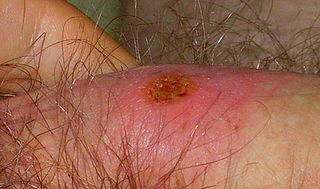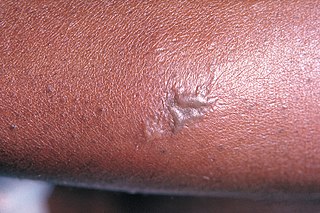Related Research Articles

Syphilis is a sexually transmitted infection caused by the bacterium Treponema pallidum subspecies pallidum. The signs and symptoms of syphilis vary depending in which of the four stages it presents. The primary stage classically presents with a single chancre though there may be multiple sores. In secondary syphilis, a diffuse rash occurs, which frequently involves the palms of the hands and soles of the feet. There may also be sores in the mouth or vagina. In latent syphilis, which can last for years, there are few or no symptoms. In tertiary syphilis, there are gummas, neurological problems, or heart symptoms. Syphilis has been known as "the great imitator" as it may cause symptoms similar to many other diseases.

Treponema pallidum, formerly known as Spirochaeta pallida, is a spirochaete bacterium with various subspecies that cause the diseases syphilis, bejel, and yaws. It is transmitted only among humans. It is a helically coiled microorganism usually 6–15 μm long and 0.1–0.2 μm wide. T. pallidum's lack of either a tricarboxylic acid cycle or oxidative phosphorylation results in minimal metabolic activity. The treponemes have a cytoplasmic and an outer membrane. Using light microscopy, treponemes are visible only by using dark field illumination. Treponema pallidum consists of three subspecies, T. p. pallidum, T. p. endemicum, and T. p. pertenue, each of which has a distinct associated disease.

A chancre is a painless genital ulcer most commonly formed during the primary stage of syphilis. This infectious lesion forms approximately 21 days after the initial exposure to Treponema pallidum, the gram-negative spirochaete bacterium yielding syphilis. Chancres transmit the sexually transmissible disease of syphilis through direct physical contact. These ulcers usually form on or around the anus, mouth, penis and vagina. Chancres may diminish between four and eight weeks without the application of medication.

Yaws is a tropical infection of the skin, bones, and joints caused by the spirochete bacterium Treponema pallidum pertenue. The disease begins with a round, hard swelling of the skin, 2 to 5 cm in diameter. The center may break open and form an ulcer. This initial skin lesion typically heals after 3–6 months. After weeks to years, joints and bones may become painful, fatigue may develop, and new skin lesions may appear. The skin of the palms of the hands and the soles of the feet may become thick and break open. The bones may become misshapen. After 5 years or more, large areas of skin may die, leaving scars.

Tabes dorsalis is a late consequence of neurosyphilis, characterized by the slow degeneration of the neural tracts primarily in the dorsal root ganglia of the spinal cord. These patients have lancinating nerve root pain which is aggravated by coughing, and features of sensory ataxia with ocular involvement.

Chancroid is a bacterial sexually transmitted infection characterized by painful sores on the genitalia. Chancroid is known to spread from one individual to another solely through sexual contact. However, there have been reports of accidental infection through the hand. While uncommon in the western world, it is the most common cause of genital ulceration worldwide.

Albert Ludwig Sigesmund Neisser was a German physician who discovered the causative agent (pathogen) of gonorrhea, a strain of bacteria that was named in his honour.

Congenital syphilis is syphilis present in utero and at birth, and occurs when a child is born to a mother with syphilis. Untreated early syphilis infections results in a high risk of poor pregnancy outcomes, including saddle nose, lower extremity abnormalities, miscarriages, premature births, stillbirths, or death in newborns. Some infants with congenital syphilis have symptoms at birth, but many develop symptoms later. Symptoms may include rash, fever, an enlarged liver and spleen, and skeletal abnormalities. Newborns will typically not develop a primary syphilitic chancre but may present with signs of secondary syphilis. Often these babies will develop syphilitic rhinitis ("snuffles"), the mucus from which is laden with the T. pallidum bacterium, and therefore highly infectious. If a baby with congenital syphilis is not treated early, damage to the bones, teeth, eyes, ears, and brain can occur.
Pinta is a human skin disease caused by infection with the spirochete Treponema carateum, which is morphologically and serologically indistinguishable from the bacterium that causes syphilis. The disease is endemic to Mexico, Central America, and South America.

Neurosyphilis refers to infection of the central nervous system in a patient with syphilis. In the era of modern antibiotics, the majority of neurosyphilis cases have been reported in HIV-infected patients. Meningitis is the most common neurological presentation in early syphilis. Tertiary syphilis symptoms are exclusively neurosyphilis, though neurosyphilis may occur at any stage of infection.

A Jarisch–Herxheimer reaction is a reaction to endotoxin-like products released by the death of harmful microorganisms within the body during antibiotic treatment. Efficacious antimicrobial therapy results in lysis (destruction) of bacterial cell membranes, and in the consequent release into the bloodstream of bacterial toxins, resulting in a systemic inflammatory response.

Sahachirō Hata was a prominent Japanese bacteriologist who researched the bubonic plague under Kitasato Shibasaburō and assisted in developing the Arsphenamine drug in 1909 in the laboratory of Paul Ehrlich.
A genital ulcer is an open sore located on the genital area, which includes the vulva, penis, perianal region, or anus. Genital ulcers are most commonly caused by infectious agents. However, this is not always the case, as a genital ulcer may have noninfectious causes as well.
Treponema denticola is a Gram-negative, obligate anaerobic, motile and highly proteolytic spirochete bacterium. It is one of four species of oral spirochetes to be reliably cultured, the others being Treponema pectinovorum, Treponema socranskii and Treponema vincentii. T. denticola dwells in a complex and diverse microbial community within the oral cavity and is highly specialized to survive in this environment. T. denticola is associated with the incidence and severity of human periodontal disease. Treponema denticola is one of three bacteria that form the Red Complex, the other two being Porphyromonas gingivalis and Tannerella forsythia. Together they form the major virulent pathogens that cause chronic periodontitis. Having elevated T. denticola levels in the mouth is considered one of the main etiological agents of periodontitis. T. denticola is related to the syphilis-causing obligate human pathogen, Treponema pallidum subsp. pallidum. It has also been isolated from women with bacterial vaginosis.
Treponematosis is a term used to individually describe any of the diseases caused by four members of the bacterial genus Treponema. The four diseases are collectively referred to as treponematoses:

Gonorrhea, colloquially known as the clap, is a sexually transmitted infection (STI) caused by the bacterium Neisseria gonorrhoeae. Infection may involve the genitals, mouth, or rectum. Infected men may experience pain or burning with urination, discharge from the penis, or testicular pain. Infected women may experience burning with urination, vaginal discharge, vaginal bleeding between periods, or pelvic pain. Complications in women include pelvic inflammatory disease and in men include inflammation of the epididymis. Many of those infected, however, have no symptoms. If untreated, gonorrhea can spread to joints or heart valves.

Syphilis is a bacterial infection transmitted by sexual contact and is believed to have infected 12 million people in 1999 with greater than 90% of cases in the developing world. It affects between 700,000 and 1.6 million pregnancies a year, resulting in spontaneous abortions, stillbirths, and congenital syphilis. In Sub-Saharan Africa syphilis contributes to approximately 20% of perinatal deaths.

The first recorded outbreak of syphilis in Europe occurred in 1494/1495 in Naples, Italy, during a French invasion. Because it was spread by returning French troops, the disease was known as "French disease", and it was not until 1530 that the term "syphilis" was first applied by the Italian physician and poet Girolamo Fracastoro. The causative organism, Treponema pallidum, was first identified by Fritz Schaudinn and Erich Hoffmann in 1905. The first effective treatment, Salvarsan, was developed in 1910 by Sahachiro Hata in the laboratory of Paul Ehrlich. It was followed by the introduction of penicillin in 1943.

Meningeal syphilis is a chronic form of syphilis infection that affects the central nervous system. Treponema pallidum, a spirochate bacterium, is the main cause of syphilis, which spreads drastically throughout the body and can infect all its systems if not treated appropriately. Treponema pallidum is the main cause of the onset of meningeal syphilis and other treponemal diseases, and it consists of a cytoplasmic and outer membrane that can cause a diverse array of diseases in the central nervous system and brain.

Syphilis, a sexually transmitted disease, is a major danger to public health, particularly in developing countries, including those in sub-Saharan Africa. The disease, whose origin is contested amongst researchers, arrived in Africa no later than the 16th century. Since then, it has spread to individuals across the continent. It heavily affects pregnant women, who can end up miscarrying or giving birth to a child already infected. Its relationship with factors such as circumcision, education, and the availability of screening have all been researched.
References
- 1 2 3 4 5 "Faculty spotlight: Dr. Sheila Lukehart | Department of Medicine News". mednews.uw.edu. Retrieved 2023-02-26.
- ↑ LUKEHART, SHEILA A. (2008). "Scientific Monogamy: Thirty Years Dancing with the Same Bug 2007 Thomas Parran Award Lecture". Sexually Transmitted Diseases. 35 (1): 2–7. ISSN 0148-5717.
- 1 2 3 "Sheila Lukehart elected to Fellowship in the American Academy of Microbiology". mednews.uw.edu. Retrieved 2023-02-26.
- ↑ "From the ASTDA". Sexually Transmitted Diseases. 35 (1): 1. January 2008. doi:10.1097/OLQ.0b013e318162cb6b. ISSN 0148-5717.
- ↑ "Syphilis Genome Sequenced". www.science.org. Retrieved 2023-02-26.
- ↑ Öffentlichkeitsarbeit, Georg-August-Universität Göttingen-. "Sheila Lukehart - Georg-August-Universität Göttingen". Georg-August Universität Göttingen (in German). Retrieved 2023-02-26.
- ↑ admin. "Recognition Awards". ASTDA. Retrieved 2023-02-26.